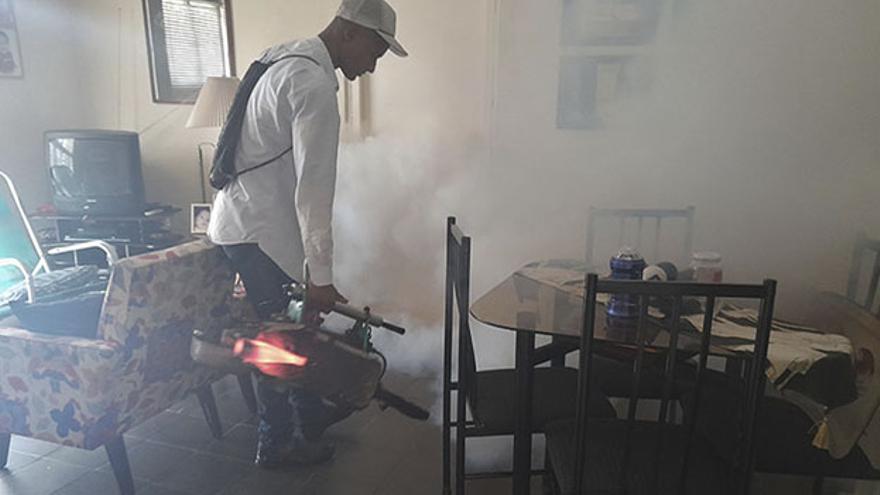
![]() 14ymedio, Havana, 17 August 17, 2023 — The authorities of Sancti Spíritus and Ciego de Ávila have decreed the “epidemic phase” in the rise of dengue fever infections. After registering a rate of 14.4 patients per 1,000 in the last week – and although the neighboring province does not reveal its figures – the Ministry of Public Health said that there are different variants of the disease circulating in the central area of the country, and the panorama tends to get complicated.
14ymedio, Havana, 17 August 17, 2023 — The authorities of Sancti Spíritus and Ciego de Ávila have decreed the “epidemic phase” in the rise of dengue fever infections. After registering a rate of 14.4 patients per 1,000 in the last week – and although the neighboring province does not reveal its figures – the Ministry of Public Health said that there are different variants of the disease circulating in the central area of the country, and the panorama tends to get complicated.
In an interview published this Wednesday in the official media Escambray, the director of the Center for Hygiene, Epidemiology and Microbiology in Sancti Spíritus, Carlos Ruiz, said that the numbers in the province are below the national average, but the situation is still “worrying.”
Although many municipalities are not at risk presently, others have high rates of infection. The most complex case is that of La Sierpe, an area with few inhabitants but one that has presented a rate of 108.8 patients per 1,000 inhabitants in the last week.
As for the head municipality and Trinidad, two of the most affected, the diagnosed rate is 14.2 and 14.7 people per 1,000 inhabitants, respectively.
For their part, the authorities of neighboring Ciego de Ávila also warned of the presence of two dangerous variants of the virus, which accelerate discomfort in the infected, and an increase in infections. In mid-June, the province registered 152 outbreaks in just one week in the head municipality alone. In others, such as Baraguá, Morón and Ciudad del Gallo, up to 21 possible infections were recorded daily. This August, Morón became the second municipality with the most infections, behind Ciego de Ávila.
According to a report in the official newspaper Invasor this Thursday, the situation in the province has not improved, and the authorities admit that “not much has changed.”
The responsibility, they add, lies with the families, who “do not comply with staying at home” and go to work or on vacation. They do not check the possible foci, refuse to take the test to identify the virus or don’t declare symptoms.
To this is added the lack of personnel to carry out investigations, the malfunctioning of community groups, the shortage of medical supplies to diagnose and treat the disease, and the absence of fuel to fumigate, which has forced them to cut down on services.”
Another critical situation, which contributes to the spread of dengue on the Island, is the number of landfills and garbage dumps that have appeared in Cuban cities in recent years, without anyone taking care of them.
“Today the course of dengue in the province tends to increase the number of suspected cases, the incidence rate and the speed of transmission. Intensive actions in the areas identified as high epidemiological risk are limited to the blocking off cases (fumigating the patient’s house and the adjacent ones),” says the newspaper. With these statistics, and although the officials are not clear about it, the country already entered the epidemic phase some time ago.
Cuba has been announcing the development of an immunogen against the dengue virus for 10 years. This February, Eduardo Martínez Díaz, president of BioCubaFarma, said that finally this 2023, they will have the first vaccine candidate, but so far neither the authorities of the Ministry of Public Health nor the state group have given details of the progress of the research. The Government defends itself by saying that the delays in the development of the drug are due to the complexity of the four serotypes of the virus.
Meanwhile, cholera has also become a risk for the families of Guantánamo. The Ministry of Public Health announced on Wednesday that it will strengthen surveillance after an increase in cases of the bacterial disease in neighboring countries, especially in Haiti.
The airport authorities have already begun to take measures to prevent cholera from reaching the Island by air. Passengers entering countries with active cases are given a dose of doxycycline, an antibiotic used to prevent the development of bacteria. In addition, there will be clinical surveillance for two weeks from entry. In the case of people who are dehydrated, they will be tested to rule out contagion.
Translated by Regina Anavy
____________
COLLABORATE WITH OUR WORK: The 14ymedio team is committed to practicing serious journalism that reflects Cuba’s reality in all its depth. Thank you for joining us on this long journey. We invite you to continue supporting us by becoming a member of 14ymedio now. Together we can continue transforming journalism in Cuba.
